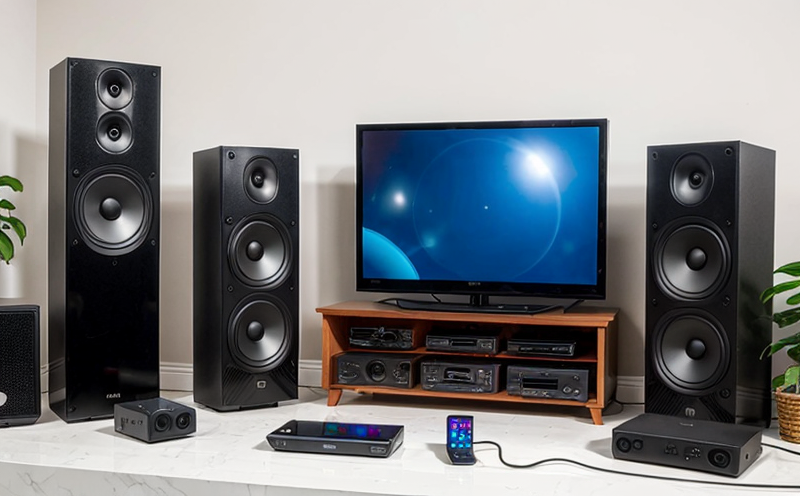ISO 9296 Sound Power Level Testing for Consumer Devices
The ISO 9296 standard provides a method to determine sound power levels of electrical and electronic devices. This is particularly important in the consumer electronics sector, where compliance with noise regulations ensures that products meet stringent environmental protection standards.
In this context, sound power level testing is crucial for consumer audio (A/V) devices such as headphones, speakers, televisions, and other similar products. The primary objective of this test is to identify any excessive noise emissions that could be harmful to users or disruptive in public spaces.
The process involves placing the device under controlled conditions where its sound power levels are measured using specialized equipment designed according to ISO 9296 guidelines. This helps manufacturers ensure their products comply with international standards like IEC, CE marking requirements, and other local regulations.
Sound Power Level testing is essential for several reasons:
- To identify potential issues early in the product development cycle
- To compare different designs or versions of a product
- To validate changes made based on previous test results
- To ensure consistency across manufacturing batches
For quality managers and compliance officers, understanding this process is vital. It allows them to oversee the testing procedures and ensure that all devices meet the necessary sound power level limits.
| Test Parameters | Acceptance Criteria |
|---|---|
| Sound Power Levels (SPL) | Must not exceed specified limits as per ISO 9296 |
| Measurement Conditions | Defined by the standard in terms of environment and setup |
| Instrumentation | Usage |
|---|---|
| Sound Power Meter | For direct measurement of sound power levels |
| Anechoic Chamber | To provide controlled acoustic conditions during testing |
The data collected from these tests can be used to fine-tune product designs, improve user experience, and ensure regulatory compliance. For R&D engineers, this information is invaluable as it informs iterative improvements that enhance both performance and marketability.
Why Choose This Test
- Ensures compliance with international standards such as ISO 9296 and IEC
- Identifies potential noise issues early in the development cycle
- Reduces the need for post-manufacturing modifications due to non-compliance
- Promotes consistent quality across production batches
- Aids in meeting stringent environmental protection regulations
- Enhances brand reputation by ensuring products are safe and user-friendly
- Facilitates easier market entry into countries with strict noise emission laws
Quality and Reliability Assurance
The ISO 9296 sound power level testing is integral to a comprehensive quality assurance program. By incorporating this test, manufacturers can ensure that their products are not only compliant with international standards but also reliable and safe for end users.
This testing process involves several stages, each contributing significantly to the overall reliability of the product:
- Device Preparation: Ensuring the device is in its intended operational state
- Environmental Control: Maintaining consistent environmental conditions during testing
- Data Collection: Gathering precise measurements using approved equipment and methodologies
- Analysis: Interpreting collected data to determine compliance with specified limits
- Reporting: Documenting findings comprehensively for future reference and regulatory submission
The reliability of the testing process is further enhanced by regular calibration of instruments, adherence to standard protocols, and continuous training of personnel involved in the testing. This ensures that the results are accurate and can be trusted.
Use Cases and Application Examples
The ISO 9296 sound power level test is widely used across various consumer electronics devices to ensure they meet noise emission standards. Below are some specific use cases:
| Device Type | Purpose of Testing |
|---|---|
| Headphones and Earbuds | Measuring the noise level to ensure it does not cause discomfort or hearing damage |
| Speakers | Evaluating sound power levels to prevent unnecessary loudness in public spaces |
| Televisions | Checking for any excessive background noise that could interfere with viewing experience |
These tests are also critical during product development phases, helping engineers refine design iterations until they meet all necessary specifications. For procurement teams, understanding these testing protocols ensures they select suppliers who adhere to high-quality standards.





